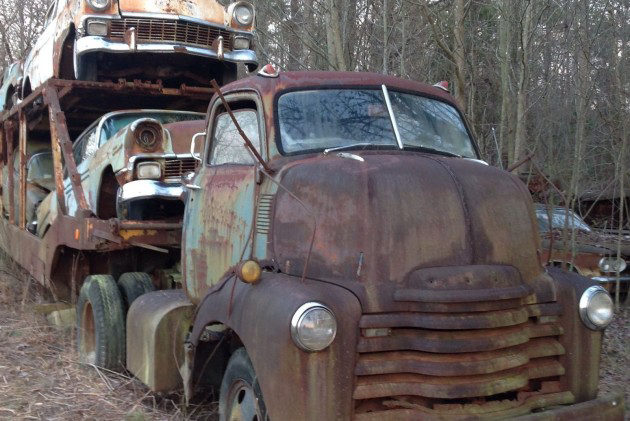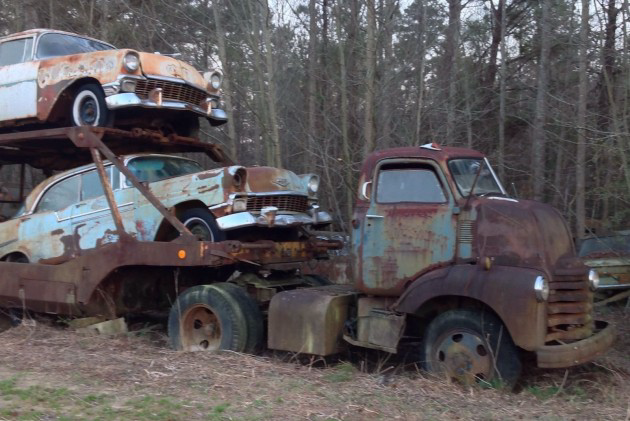
I get to thinking sometimes that I’ve been around so long that I’ve seen everything. Nothing new under the sun, nothing can surprise me. Occasionally, I am proven wrong about that. Rarely is it as spectacular as this. If you’ve been in the old car hobby for many years, decades maybe, you might get to thinking that you’ve seen it all. Thanks goes to Blindmarc for the tip!

But you have not seen it all, and as evidence to support that position, allow me to present Exhibit A: One 1950 Chevrolet COE truck, coupled to a car carrier trailer which is loaded up and complete with not one, but four, rusty 1956 Chevy passenger cars.

The seller’s ad appears here on ebay. His opinion is that this setup would be great for drawing attention to a business, or as an ultimate expression of yard art. That is unassailable fact.

But there’s much more to it than that. Four rusty cars and a truck and trailer? Maybe to those eggheads at the county planning and zoning commission. To the true dyed-in-the-wool motor head, this is a heavenly, car spotter’s bliss. A non-rolling automotive Mecca, if you will. It would stop traffic and cause accidents. If there were a way to drag this mess to a car show, after awhile all the shiny-car owners would give up and go home in despair. They’d close their hoods, start their chrome-laden engines, idle slowly off the parking lot and drive away as the crowd surrounded….this.

Rusty treasure. The seller says they’re all non-restorable and have no titles, but frankly, who cares? Is there a title for the Parthenon? The Taj Mahal? The Statue of Liberty?

I often joke about “aggravating my neighbors” by bringing home some obnoxious new-old car. Clearly, this is the Holy Grail. If I could park it on my street in front of my house, even for just a day, they would then know who they were dealing with. Someone who has attained the status of least a demigod. They would surround me on their hands and knees and worship the ground I walk on and the lawn I park my cars on. They would throw small loaves of bread at my feet. I’m not entirely sure why about that last part.

But back to reality. The seller’s $15,000 asking price is not enough. He has already lived the dream, and has recognized his obligation to now share the blessing with the rest of mankind.

The seller says the cars are complete with engines, transmissions and some trim parts, but are in rough condition. There are two four-door sedans, one two-door sedan Bel Air, and one four-door hardtop Bel Air. These details don’t matter, only the feeling of Zen that I get when I see it does.
 This beautiful, rusted offering is located in Wilson, North Carolina. The tip for the write-up came from Barn Finds faithful reader Troy W, to whom I am eternally grateful.
This beautiful, rusted offering is located in Wilson, North Carolina. The tip for the write-up came from Barn Finds faithful reader Troy W, to whom I am eternally grateful.Source: barnfinds.com











